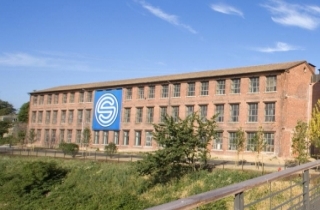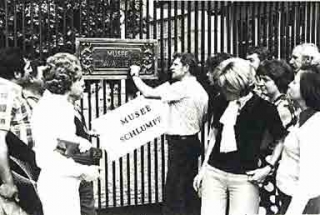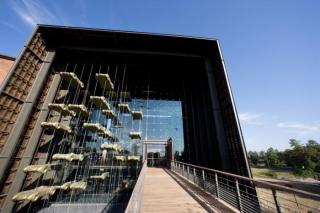The history of the Museum
1904 - 1956 : the Schlumpf brothers
Hans and Fritz Schlumpf were born in Italy in 1904 and 1906 respectively. Their father was Swiss and their mother, Jeanne Becker, was from Mulhouse, where the family settled in 1906. Their father, Carl, worked as an accountant for the horticultural company Becker. However, his health declined and he died in August 1918.
Hans was sent to a private school in Switzerland and obtained a Higher Diploma in Business. He then worked in two banks before going into business with his brother in 1929.
Fritz attended and graduated from Mulhouse state high school. He found employment in the textile industry, and started his own business as a wool broker in 1928.
In 1935, the two brothers founded SAIL (a public limited company in the wool industry) and bought their first shares in the Malmerspach spinning mill. They took control of various companies in 1940 and again in 1956 at Erstein and Roubaix.
1957 - 1965 : HKD, a textile factory
In 1957, the Schlumpf brothers bought the HKD textile factory, a former woollen mill in Mulhouse. Between 1961 and 1963, Fritz Schlumpf secretly bought large numbers of classic cars. To make these purchases, he linked up with various buyers in France, Switzerland, England, Italy, Germany and the USA. Some of these contacts were particularly fruitful - half of his collection (over 200 cars) came from just 13 of them. These included Mr Rafaelli, a Renault dealer who owned several Bugattis and agreed to be his buying adviser – a collaboration that lasted several years. Fritz Schlumpf continued to use his industrial wealth to buy up classic European cars, while avoiding American models.
In May 1965, the first article revealing the size of this secret collection appeared in the Alsace press. Only a privileged few had been allowed access to the warehouses holding the cars.
1966 - 1976 : the “Schlumpf Museum”
In 1966, work on displaying the collection began. Fritz Schlumpf’s aim was to reveal to the public for the first time the exceptional collection that he had managed to bring together in just a few years. He developed part of the factory warehousing to create the “Schlumpf Museum”. This substantial project took several years. All internal walls, which had separated the various production areas, were removed from this sawtooth-roof building. The newly created exhibition hall with 17,000 m² of unified space was subdivided into 23 “districts”, each containing 10-20 cars. These were surrounded by a couple of miles of wide, tiled walkways, with names such as “Avenue Carl Schlumpf”, “Avenue Jeanne Schlumpf” and “Rue Royale”. Various service areas were developed around this.
At the same time, restoration work on the cars was stepped up. This required seven assistant mechanics, two upholsterers, two body-work specialists, an assistant body-work specialist and five painters. Purchasing and exhibiting this collection cost Fritz Schlumpf around 12 million French francs over 10 years.
By 28 June 1976, the textile factory was in crisis and its employees were on strike. The unions condemned the Schlumpf brothers for “lack of consultation” and “illegal acts”. The brothers tried to sell their factories for a symbolic one French franc. But when no offers were received, they quit and took refuge in Basel. They would never return to France.
At the end of 1976, the 20 remaining workers at the HKC factory (the renamed HKD factory) were made redundant and the building was sealed. A long period of legal battles between the Schlumpf brothers and their creditors followed.
1977 - 1979 : the “Workers Museum”
On 7 March 1977, the warehouses were occupied by the unions. The “Schlumpf Museum” was renamed the “Workers Museum”. It was overseen by the CFDT union and entry was free. A collection was taken on the way out to cover both running costs and the costs of ongoing legal action. “I used to earn 1,400 francs a month: here’s where the rest went” read one of the many placards placed on the grill of a racing car. This was the beginning of “The Schlumpf Affair”…
In 1978, at the instigation of Jean Panhard, the French Council of State classed the collection as a Historical Monument, meaning that no part could leave French territory.
In 1979, the Colmar Appeals Court ordered liquidation of the Schlumpf brothers’ personal assets including the collection of classic cars restored using company funds. A few hours after this Order, the CFDT handed over the keys to the factory.
1980 - 1981 : the Musée National de l'Automobile (French National Automobile Museum)
In October 1980, the French supreme court authorised the sale of the collection and the following year it was purchased by the National Automobile Museum Association. This association comprised the City of Mulhouse, the Haut-Rhin Département, the Alsace Region, the Mulhouse Chamber of Commerce, the Automobile Club de France, the Panhard Company and the organisers of the Paris Motor Show. It was chaired by the President of the Haut-Rhin General Council and raised the 44 million Francs required to purchase the collection. This valuation was to be contested by the Schlumpf brothers, who won their case 20 years later and obtained a further 25 million Francs.
The National Automobile Museum opened to the public on 10 July 1982.
1989 - 2006 : National Automobile Museum – Schlumpf Collection
In 1989, following Orders from the Paris Appeal Court, the National Automobile Museum was forced to add “Schlumpf Collection” to its name and to all documents mentioning part of the collection.
In 1999, Museum operation was entrusted to the company Culturespaces. On 25 March 2000, after considerable renovation and modernisation work, Culturespaces opened the world’s largest car museum to the public. Three objectives had guided the museum renovation work: preserving its identity, effectively displaying its collection and designing a modern, vibrant project. A new layout using the latest multimedia innovations brings it to life, while respecting the spirit of the original.
2006 - 2007 : La Cité de l'Automobile - National Museum - Schlumpf Collection
In July 2006, Culturespaces opened new areas designed by Studio Milou Architecture. These include the entrance to the Museum (forecourt, footbridge, atrium, projection wall) and the three exhibition spaces at the end of the tour. The main aim of this project was to move from a closed collection to a museum open to the outside world, where both beginners and enthusiasts can explore the whole of this former mill which extends over an area larger than eight football pitches. The designers wanted to highlight the exceptional architectural heritage of this former factory. The Museum now has a highly original layout with a new visitor circuit around the various period buildings (1880 – 1930) and the factory courtyard. The National Automobile Museum has become La Cité de l'Automobile – National Museum – Schlumpf Collection.




